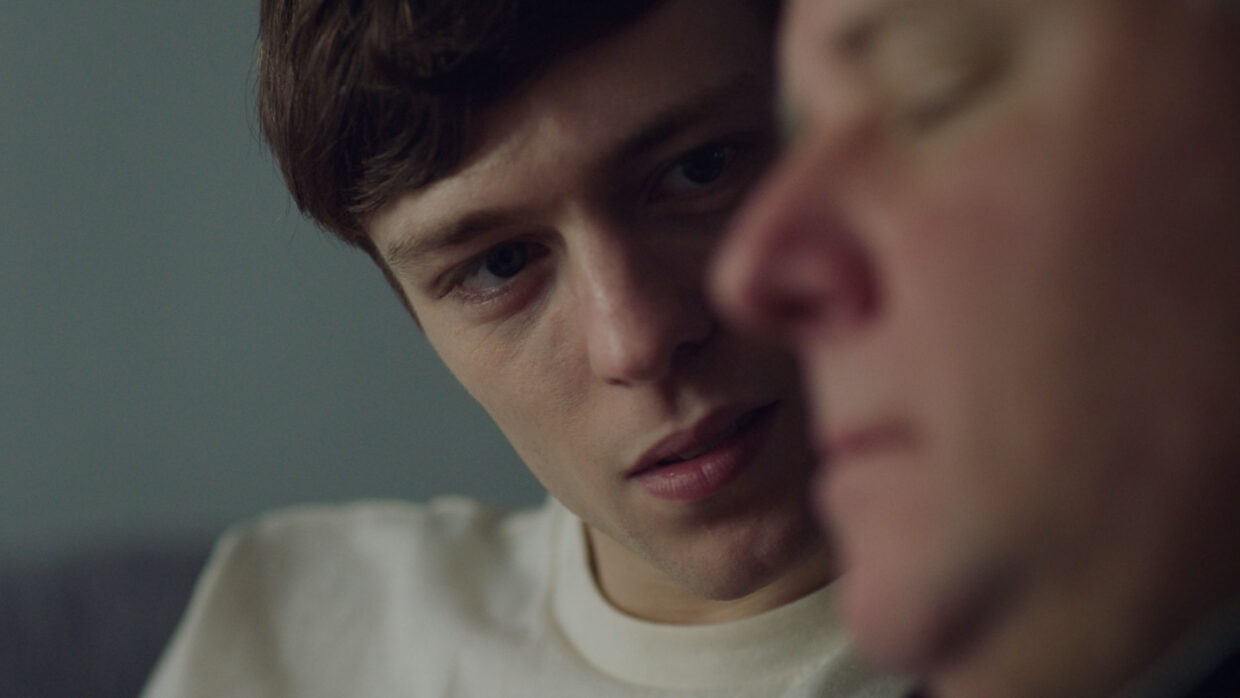 Back to selection
Back to selection
“I Prepared Myself by Digesting a Lot of Close-Ups and Portraits”: DP Iikka Salminen on Sebastian
 Ruaridh Mollica and David Nellist appear in Sebastian by Mikko Mäkelä, an official selection of the World Dramatic Competition at the 2024 Sundance Film Festival. Courtesy of Sundance Institute.
Ruaridh Mollica and David Nellist appear in Sebastian by Mikko Mäkelä, an official selection of the World Dramatic Competition at the 2024 Sundance Film Festival. Courtesy of Sundance Institute. In Sebastian, Finnish-British writer-director Mikko Mäkelä’s follow-up to 2017’s A Moment in the Reeds, 25-year-old Max enters the world of sex work as research for his debut novel. These experiences alter Max’s sense of self as Max moves from hesitant to exhilarated as he throws himself deeper into his “double life.”
Cinematographer Iikka Salminen, who also worked with Mäkelä on A Moment in the Reeds, discusses how he complemented the observational nature of the film by shooting it like a “moving portrait.”
See all responses to our annual Sundance cinematographer interviews here.
Filmmaker: How and why did you wind up being the cinematographer of your film? What were the factors and attributes that led to your being hired for this job?
Salminen: Me and the director, Mikko Mäkelä, go way back. I believe he appreciates someone who is not afraid of changes, and who can react quickly to last minute ideas, and create images in the moment.
Filmmaker: What were your artistic goals on this film, and how did you realize them? How did you want your cinematography to enhance the film’s storytelling and treatment of its characters?
Salminen: I aimed to support the character-driven nature of the film by using longer focal lengths and a deliberate compositional style to create a “moving portrait”-like imagery. This also served the observational style of the film, going hand-in-hand with the concept of the audience observing the main character, much like he observes his life in his autobiographical writing.
We didn’t want to overly dramatize the themes visually with grittiness but rather chose to find elegance. This gave options on being a bit bolder with choices in lighting and creating mood. Opting to shoot scenes based on their feel infused a more expressive reflection of the story into the imagery.
The image was further manipulated by the use of vintage lenses and filtering to create a softer and more organic look to break away from the electricity of the digital medium. This approach felt right and took us closer to the vision.
Filmmaker: Were there any specific influences on your cinematography, whether they be other films, or visual art, of photography, or something else?
Salminen: Following the idea of shooting “a portrait in motion,” I prepared myself by digesting a lot of close-ups and portraits in photography and film. This led to choosing the 1.85:1 aspect ratio, which enabled close-ups to fill the frame the right way for us. The film was shot mainly on 50mm and 85mm lenses, which helped to create isolation and put emphasis on the portrait nature of the film.
Filmmaker: What were the biggest challenges posed by production to those goals?
Salminen: There was quite a bit of traveling during the production, and some tough locations which put some pressure on the visual consistency, but my crew was always on point which made my life very easy.
Filmmaker: What camera did you shoot on? Why did you choose the camera that you did? What lenses did you use?
Salminen: Arri Alexa Mini was paired with Canon K35s. Additionally, Angénieux Zoom 25-250HR was used for anything longer than 85mm. Alexa was a natural choice for me due to its color and texture. I tested quite a few vintage sets but landed on K35s. They had that painterly quality that I was looking for and rendered faces beautifully, which helped in achieving the artistic goals.
Filmmaker: Describe your approach to lighting.
Salminen: On this film I relied on as few sources as possible. We moved so much during the shoot we had to find efficient ways of maintaining the mood without overcomplicating it. I tried not to overintellectualize the lighting but rather went with what felt right. It was also important to adjust to the director’s, style which required a lot of freedom and adaptability—things on set could change rather quickly.
Filmmaker: What was the most difficult scene to realize and why? And how did you do it?
Salminen: Without spoiling the film I can give you a hint: Toilets—we shot in a lot of toilets. They tend to not be particularly spacious places, and hiding gear and crew can be a bit tough.
Filmmaker: Finally, describe the finishing of the film. How much of your look was “baked in” versus realized in the DI?
Salminen: The film was shot on two LUTs created specifically for this film—one for the day and one for the night. The look created on set through camera, lighting, and production design was then further enhanced on a scene level in the DI. This made the process quite fast, and we finished off with a little bit of grain on top.
TECH BOX
Film Title: Sebastian
Camera: Arri Alexa Mini
Lenses: Canon K35 & Angénieux Zoom HR
Lighting: Creamsource, Astera, Rosco, Arri, Litegear, Kinoflow
Processing: DI
Color Grading: Veerle Zeelmaekers & Peter Bernaers at Flow (Baselight)
